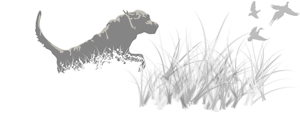You have no items in your shopping cart.
Using a Check Cord for Training

Whether you training pointers, retrievers or any other kind of hunting dog you can benefit from using a check cord. Most trainers consider it the most important tool they own.
While most training tools come with extensive manuals and instructions the check cord, being the simple tool that it is, can actually be quite confusing to understand but yet it has no definite instruction manual.
Countless dog owners will misuse the check cord and claim their dog isn’t trainable but, really the problem usually lies with the trainer, not the dog.
What is a Check Cord?
Your first order of business is understanding exactly what a check cord is. A proper check cord will be tight woven and stiffer than the typical leash, keeping it from tangling when you are working at an increased distance from your dog. It is best to have a cord that has a high visibility as you will eventually let go of the cord.
The length of the check cord can vary by what you prefer but, they usually run from about 20 to 30 feet long.The check cord will have a durable snap closure that can be easily connected to a heavy duty collar that has a D-ring allowing for optimum sensitivity for the movement across his neck. It can be mistaken for a glorified leash but, a leash is used for a completely different purpose, like to walk your dog beside you.
While the check cord is used to teach your dog to walk in front of you while you hunt and to keep your dog at a consistent distance from the birds. Using the check cord is a matter of controlling your dog or more importantly controlling his approach of the bird. Often referred to as a reinforcer of limits.
Lightweight and easy to coil and carry, this high-visibility 30 foot orange check cord is soft on your hands and tangle-free... [read more].
When Do You Use a Check Cord?
Timing is everything. During training, when you have established a bond and trust with your dog and he has proven himself capable and disciplined enough to handle simple commands, especially those commands that work on the lead, like how to sit still until you tell him to move, then it might be time to break out the check cord.
Rushing your dog is always a bad idea especially when training using the check cord because it should go smoothly and without a lot of fuss. If he’s not ready for it then it just ends up wasting time that you could be spending developing his other commands.
How Do you Use a Check Cord?
Using the check cord, you can start close with your dog out front and gradually work more space between you all the while, you maintain control. If at any point you lose control, start over. Try to use the same training routine that you have established for other commands.
If he follows and understands the short distance then move on to the next distance maintaining control along the way. Slow and steady is the best policy for any kind of dog training and can save you the time and trouble of having to break bad habits.
What Is A Check Cord Used For?
The check cord has several different purposes and can vary from trainer to trainer. We will discuss a few of the commands that the check cord is used to perfect: Stay with me; go with me; or come to me . It is best to start with “stay with me” since it is typically the simplest command and if he is properly trained he will already know to stay with you until you tell him to go, it is just a matter of making him aware of the cord. You simply attached the cord to his collar and use it to “talk” to him.
Making sure that when you want him to stay with you, you will deliver a slight tug and praise him non-verbally, like with a pat on the head or other non-verbal communication. So after you establish that he will stay with you, you should then move on to the “go with me” command. It is best to start by first taking a quick step forward and with the cord in place give it a few quick, light tugs. The dog should then understand to go with you, changing your pace and direction frequently and making him follow closely not cutting corners and running ahead of you.
Be sure to correct him when he doesn’t follow directly. After he is successful with “go with me” you can move on with “come to me”.Teaching him to come to you will be slightly easier than the “go with me” however, be careful not to verbalize “come” so that he learns to come to you at the slight pull of the cord.
Other Uses
There are also other times that a check cord comes in handy like keeping your duck dog from jumping in the water too early. It is also an excellent tool to use to keep him from messing up another dog’s point. Once you’ve used a check cord, you will come up with other ways to enhance your hunting experience using this simple yet efficient tool.
As with all training patience and consistency will get you the best results. Don’t spend more time each day training with the check cord than you would any other training drill. A short amount of quality training is better than a worn out bored dog getting frustrated because he’s had enough.














